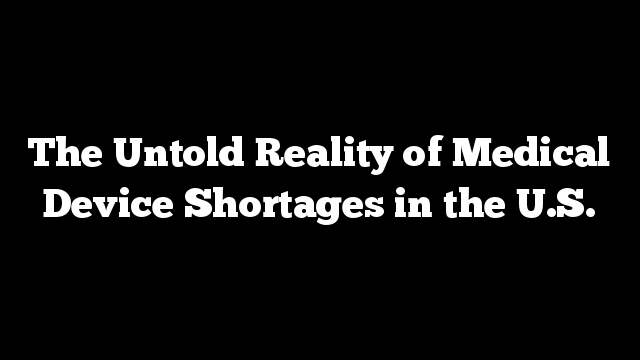

By CHAUN POWELL, MBA and SOUMI SAHA, PharmD, JD
Say the word “shortage” to a healthcare professional and chances are the first thing that will come to mind is drug shortages. With good reason, too – there are more than 100 drugs currently at risk or not readily available for U.S. hospitals, according to the Food and Drug Administration’s (FDA) drug shortage list.
Shortages don’t just apply to drugs, however, and as 2019 has shown, healthcare providers must become more focused on shortages of the medical device variety. The shutdown of multiple medical device sterilization facilities in 2019 is poised to jeopardize the availability of devices that are critical to routine patient care. On Nov. 6, the FDA is hosting a panel to hear from stakeholders, including hospital epidemiologists and healthcare supply chain experts, on the risks associated with facility shutdowns and potential action steps.
The industry as a whole is in need of meaningful solutions. As taxpayers, patients and key stakeholders in healthcare, we must collaborate to eliminate interruptions to our healthcare supply chain. For those invested in improving healthcare from the inside, this means working across competitive boundaries and borrowing best practices from sister industries as we work to identify the root cause of these issues and provide meaningful and preventative solutions.
Supply chain is the second largest expense to healthcare providers in the U.S. behind labor. Where other industries have more predictable and transparent supply chain visibility, healthcare has historically proven to be more complex due to unique patient needs and physician preferences for specific products. Thus, sourcing flexibility is vital to patient care and operations, and tends to be even more constrained during shortages and market-induced scarcities. As healthcare homes in on expense reduction by targeting practice and product variation, providers depend even more on the reliability of their suppliers. Disruptions, however, lurk around every corner and there is only so much that providers or the government can do in isolation to prevent them.
Healthcare has two different legislative standards for shortages. Regulations for drug shortages and disruptions are prescriptive and mandate that manufacturers alert healthcare providers when they are likely to occur. Device shortages, however, don’t have the same regulations, resulting in inconsistent notification to providers that frequently occur weeks or months after manufacturers identify potential disruptions.
Congress and the FDA’s work to stand up a drug shortage mitigation strategy over the last decade has proven effective, and new efforts further aim to mitigate the related costs and delays to patient care. As device shortage impacts become more prevalent and more profound, we must work together between the public and private sector to find more effective means of disruption prediction, prevention and mitigation.
The Root Cause of Shortages in Healthcare
The U.S. saw a 36 percent increase in product shortages last year alone. From unpredictable demand forecasting to supplier consolidation, natural disasters, border shutdowns, tariffs, and regulatory activity, there is no limit to the number of compounding variables leading to disruptions in our healthcare supply chain. The net result is unanswered or delayed patient care. Here are some compelling facts and examples:
- Demand planning: Poor demand planning accounts for roughly 68 percent of disruptions across all industries. A third of the unplanned demand comes from the end consumer, or the healthcare organization, while 30 percent of the demand derives from the manufacturer and its tier 1 supplier. Healthcare operates differently than most other industries with commitments to suppliers with a lack of guaranteed demand over a certain period of time which only compounds the issue for manufactures in healthcare specifically.
- Storms and geographical events: Environmental disasters have downstream effects on supply availability, production and patient care. As one example, Puerto Rico is home to more than 100 medical device and pharmaceutical manufacturers and suppliers. Due to the significant tax benefits, healthcare manufacturing has become part of the culture and a main staple to the economy. Puerto Rico is also a frequent landing spot for hurricanes, as seen over the past three years with Irma, Maria and close calls with Dorian and Karen in 2019, and this geographical reality will continue to jeopardize the supply of products. It is estimated that it took a full two years for many of the manufactures on the island to return to a steady state following Maria in 2017. Had Hurricane Dorian taken a slightly different path earlier this year, those gains could have been erased.
- Margin compression pressures: As providers apply pressure on suppliers to decrease their prices in order to maintain solvency as a healthcare delivery system, suppliers are trying to figure out how to cut their costs as well. Mergers and acquisitions in the medical device industry reduce the number of manufacturers and can create bottlenecks, resulting in downstream shortages.
- Sterilization: Some healthcare providers sterilize products in-house, while others prefer sterilization plants that deliver products ready for use. As plants increase in popularity as a value-add for many manufacturers, though, their sterilization practices have come under scrutiny by neighborhoods expressing concern about environmental impacts. When the Illinois State EPA closed a sterilization plant in February, the FDA and manufacturers noted that the availability of nearly 600 devices, including sutures and stents, would likely be affected. Scrutiny from the EPAs in Michigan, California and Georgia have also resulted in further sterilization implications and shutdowns. On average, these plants sterilize 200 million products a year. Every shut down or delay impacts patient care. Although manufacturers are investing millions to respond and get ahead of the changing regulations, the end result is healthcare providers delivering care without their preferred products.
- Industry protocols and regulation: The medical device industry lacks industrywide protocols that dictate how manufacturers notify or provide clear expectations regarding a disruption, as well as procedures for how healthcare providers should respond. These protocols exist on the drug side and help prevent hoarding, but are not in place in the device industry. Therefore, the slightest hint of a rumored disruption engenders proactive hoarding of product, which exacerbates the burden on suppliers to accurately predict demand. Furthermore, unlike drugs, high-end technologies like pacemakers do not typically have generic alternatives that providers can source during a shortage.
- Economic and political policies: Tariffs and potential border shutdowns have both impacted supplier activity and investment in 2019. As manufactures try to learn from the lessons provided by the hurricanes, they are increasingly diversifying their geographical footprints and sources for raw materials. There has been inherent benefit to supply chain availability, yet the diversification in manufacturing has also lead to increasing costs compounded by tariffs. While providers seek to decrease their costs and insist on improved pricing from their suppliers, these variables have sent mixed messages to supply chains across healthcare.
Meeting in the Middle to Solve the Problem
Navigating these shortages relies on careful planning and coordination with local, regional, and national partners, as well as an understanding of practices that yield optimal results for manufacturers, providers and patients.
The industry will need to draw inspiration from innovative disaster preparedness and response programs; GPO product access programs, which leverage scale and demand aggregation to create competitive markets; and efforts to solve the shortages of high-quality drugs. Armed with these insights, Premier is putting similar programs in place for devices.
In addition to proactive creation of formal programs, advocacy with lawmakers and regulators to demonstrate the overarching need for efficient and reliable sterilization methods will be key to solving device shortages. Voices that deliver provider-facing feedback to device manufacturers, with an aim to expedite patient access and help determine the utility of new products, will rise. As the proliferation of device shortages stymies healthcare operations and detracts from uninterrupted, high-quality, cost-effective patient care, a sustainable, proactive approach will need to be multifaceted to include manufacturers’ capabilities, health systems’ greatest needs and policy recommendations. By uniting these three, we can begin to resolve this critical issue.
Chaun Powell, MBA, is Group Vice President of Strategic Supplier Engagement at Premier Inc., where he is responsible for providing leadership, strategy and execution to enhance supply chain services.
Soumi Saha, PharmD, JD, serves as the Senior Director of Advocacy at Premier Inc. where she is responsible for influencing legislative and regulatory proposals to lead the transformation to high-quality, cost-effective healthcare.
The post The Untold Reality of Medical Device Shortages in the U.S. appeared first on The Health Care Blog.
